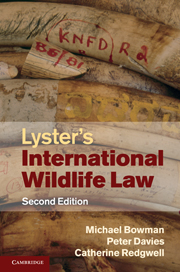Book contents
- Frontmatter
- Contents
- Foreword
- Preface
- List of abbreviations
- PART I Foundations of international wildlife law
- PART II Species regulation
- PART III Regional wildlife regulation
- PART IV Global wildlife regulation
- 13 The Ramsar Convention on Wetlands
- 14 The World Heritage Convention
- 15 The Convention on International Trade in Endangered Species of Wild Fauna and Flora
- 16 The Convention on the Conservation of Migratory Species
- PART V Biological diversity: a new perspective on wildlife regulation
- PART VI Cross-sectoral issues in wildlife regulation
- PART VII Conclusion
- Index
- References
13 - The Ramsar Convention on Wetlands
Published online by Cambridge University Press: 05 July 2011
- Frontmatter
- Contents
- Foreword
- Preface
- List of abbreviations
- PART I Foundations of international wildlife law
- PART II Species regulation
- PART III Regional wildlife regulation
- PART IV Global wildlife regulation
- 13 The Ramsar Convention on Wetlands
- 14 The World Heritage Convention
- 15 The Convention on International Trade in Endangered Species of Wild Fauna and Flora
- 16 The Convention on the Conservation of Migratory Species
- PART V Biological diversity: a new perspective on wildlife regulation
- PART VI Cross-sectoral issues in wildlife regulation
- PART VII Conclusion
- Index
- References
Summary
Background
Wetlands are estimated to cover approximately 9 per cent of the earth's land surface, and they are amongst the most productive of all ecosystems, a subtropical saltmarsh having the capacity to produce organic material at more than twice the rate of the most fertile hayfield. Similarly, coral reefs, despite covering less than 1 per cent of the world's ocean area, are home to one-third of all marine fish species, their associated fisheries yielding a catch of some 6 million metric tons annually. Apart from fish, wetlands provide essential habitat for countless species of waterfowl, amphibians, reptiles, mammals and plants. In addition, they act as natural sponges which control floods and droughts, and can absorb sediments, nutrients and toxicants, many of which are put to productive use within the wetland ecosystem. They are also an important source of water supply, with up to three billion people globally being dependent upon groundwater for drinking purposes. The total value of the services delivered by wetlands has been speculatively valued at US$14 trillion annually, and their conservation is accordingly essential. Yet in spite of these vital functions, wetlands in many parts of the world have been destroyed at an alarming rate in recent decades by excessive extraction, drainage, land reclamation and pollution. It has recently been noted that in the United States, for example, ‘over half of the 230 million hectares of wetlands that the first settlers found upon arrival has been lost’.
- Type
- Chapter
- Information
- Lyster's International Wildlife Law , pp. 403 - 450Publisher: Cambridge University PressPrint publication year: 2010



